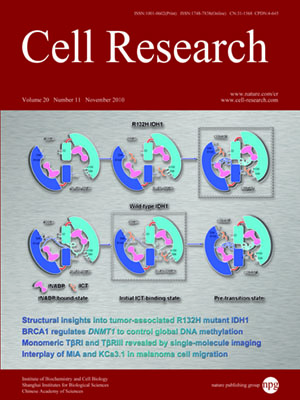
Volume 20, No 11, Nov 2010
ISSN: 1001-0602
EISSN: 1748-7838 2018
impact factor 17.848*
(Clarivate Analytics, 2019)
Volume 20 Issue 11, November 2010: 1239-1251
ORIGINAL ARTICLES
Membrane redistributions through multi-intercellular exchanges and serial trogocytosis
Estibaliz Alegre1,2,*, Kiave-Yune Ho Wang Yin2,3,*, Benoit Favier2,3, Jeremy Baudhuin2,3, Emilie Lesport2,3, Marina Daouya2,3, Alvaro Gonzalez1, Edgardo D Carosella2,3 and Joel LeMaoult2,3
1Department of Biochemistry, University Clinic of Navarra, Pamplona, Spain
2CEA, I2BM, Service de Recherches en Hemato-Immunologie, Paris F-75475, France
3UMR_E, Universit?Paris 7, IUH, Hopital Saint Louis, Paris, France
Correspondence: Joel LeMaoult,(Joel.LeMaoult@cea.fr)
Trogocytosis is a rapid transfer between cells of membranes and associated proteins. Trogocytic exchanges have been investigated between different cell types, mainly in two-cell systems, involving one donor and one acceptor cell type. Here, we studied trogocytosis in a more complex system, involving not only several immune cell subsets but also multiple tumor cells. We show that CD4
+ T cells, CD8
+ T cells and monocytes can acquire membrane patches and the intact proteins they contain from different tumor cells by multiple simultaneous trogocytoses. The trogocytic capabilities of CD4
+ and CD8
+ T cells were found to be similar, but inferior to that of autologous monocytes. Activated peripheral-blood mononuclear cells (PBMCs) may also exchange membranes between themselves in an all-autologous system. For this reason, monocytes are capable of acquiring membranes from multiple tumor cell sources, and transfer them again to autologous T cells, along with some of their own membranes (serial trogocytosis). Our data illustrate the extent of membrane exchanges between autologous activated immune effector cells and their environment, and how the cellular content of the local environment, including “bystander” cells, may impact the functions of immune effector cells.
Cell Research (2010) 20:1239-1251. doi:10.1038/cr.2010.136; published online 28 September 2010
FULL TEXT | PDF
Browse 2189


